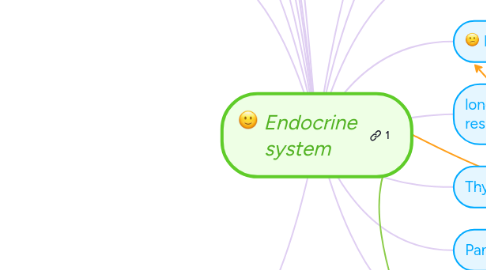
1. Resistance to thyroid hormone
2. Newborn screening
2.1. initial TTH
2.2. Simultaneous T4 and TSH assay
3. Congenital hypothyroidism
3.1. 1/2000 to 1/4000 newborns
3.1.1. majority of cases are sporadic
3.1.2. 2:1 female to male ratio
3.2. Pathogenesis
3.2.1. Resistance to TSH
3.2.1.1. Thyroid dysgenesis
3.2.2. Disorders of thyroid hormone synthesis and secretion
3.2.3. Defects in thyroid hormone transport
3.2.4. Defects in thyroid hormone metabolism
3.2.5. Transient congenital hypothyroidism
3.2.5.1. Iodine deficiency
3.2.5.2. Maternal blocking antibodies
3.2.5.3. Maternal antithyroid drugs
3.2.5.4. Iodine exposure
3.2.5.4.1. produce increased levels of type 3 deiodinase
3.2.5.5. Large hepatic hemangiomas
3.3. Clinical features
3.3.1. Jaundice
3.3.1.1. 3-4.day of life
3.3.1.2. lasts longer than physiological jaundice
3.3.2. born asymptomatic
3.3.2.1. maternal T4 crosses placenta
3.3.3. term/post term
3.3.4. Calm baby, sleeps alot
3.3.5. Slow growth
3.3.6. macroglossia, apnoe
3.3.7. constipation, big belly, umbilical hernia
3.3.8. Cardiomegaly
3.3.9. myxedema
3.3.10. Bradycardia
3.3.11. anemia
3.3.12. retardation
3.3.13. - 2.-5. day of life T4, follow up TTH
3.3.13.1. There is an inverse relationship between age at clinical diagnosis and treatment initiation and intelligence quotient (IQ) later in life, so that the longer the condition goes undetected, the lower the IQ
3.4. Treatment
3.4.1. Levotiroxin
3.4.1.1. Starts with 10-15 mcg/kg/dn
3.4.1.2. Control hormone levels after 4-6 weeks; then – once in 1-3 months in the 1. year of life; once in 2-4 months in the 2. and 3. year of life
3.4.1.3. Stops therapy around the age of 3
3.4.1.4. If a child still has hypothyroidism - permanent levotiroxin therapy
4. Central hypothyroidism
5. Hypothalamus
6. Hypophysis
6.1. Neurohypophysis
6.2. Adrenohypophysis
7. Glandula Pinealis
8. Parathyroids
9. Adrenals
9.1. Congenital adrenal hyperplasia
9.1.1. Cortizol production disorder
9.1.1.1. AKTH
9.1.1.1.1. adrenal hyperplasia
9.1.1.1.2. intermediate hormones
9.1.2. Symptoms
9.1.2.1. group of autosomal recessive disorders
9.1.2.1.1. deficiency of an enzyme
9.1.2.2. depends on the nature and severity of the enzyme deficiency
9.1.2.2.1. Classic (salt-losing)
9.1.2.2.2. microcirculation disorders
9.1.2.2.3. non classic
9.1.3. 17-OH-progesterone
9.1.4. Newborn screening
9.1.4.1. 17-hydroxyprogesterone in a randomly timed blood sample
9.1.4.1.1. greater than 3500 ng/dL
9.1.5. Treatment
9.1.5.1. • MK (Florinef) – monitoring renin
9.1.5.2. GK- monitoring AKTH
10. metabolic disorders
11. diabetes mellitus
12. Nervous system
12.1. Short terms response
13. long-term response
13.1. hormones
13.1.1. Proteins, peptides
13.1.2. Steroids
13.1.3. Amino acid derivate
